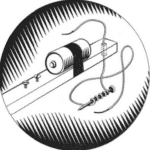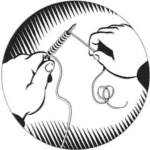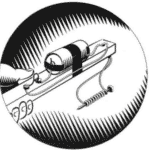Overview
Materials
Per Class:
|
Per Pair or Individual Student:
|
Instructions
Students make an electromagnet with wood and wires that they can use to “fish” for paper clips and other small metal objects.
- Drill a hole 1⁄2″ from one end of each piece of wood. It should be big enough for 2 wires to pass through. Put 2 screws into the wood. One should be 3″ from the end without the hole drilled in it and the other should be 4″ from the same end. Leave about 1⁄4″ of each screw exposed. Place the battery on the wood, near the screws. The positive terminal (button end) should face the screws. Fasten the battery to the wood with electrical tape.

- Leave 7″ of wire from the short-stripped end of the wire. Start wrapping the wire tightly around the nail, starting at the head of the nail. Stop wrapping wire around the nail when about 13″ of wire is left to the long-stripped end of the wire.
- Pull the 7″ long piece of wire through the hole. Tape the bare wire to the negative terminal side of the battery. Pull the 13″ end of the wire through the hole. Wrap the bare end of the wire, starting at the yellow insulation, around the bottom-most screw twice.

- Make a small loop at the end of the bare piece of wire. This loop will be the “on” button. Next, wrap the short (2″) wire around the top screw twice. Tape the other end to the battery.
- Test the pole: Touching and holding the loop to the top-most screw will cause electricity to flow through the wire. Make sure the connections to the battery are good.
- Scatter paper clips, grab your fishing pole, and go fish!

Guiding questions
- How might using longer lengths of wire affect the electromagnetic properties of your fishing rod?
- What do you think would happen if you used 2 batteries, and how would you do it?
- What can you try to pick up with your electromagnetic fishing pole besides paper clips?
Engineering & science connections
- An electromagnet is created with a coil of wire that is wound around an iron core. Iron alloys are made of groups of atoms which, when lined up in the right way, produce a magnetic field. Electricity flowing through the wire lines up the groups of atoms, creating a magnetic field, and turning it into an electromagnet. The more times the wire is wrapped around the nail, the stronger the magnetic field becomes. When the electrical source is turned off, the magnetic field disappears.
- Like regular magnets, electromagnets have a north and a south pole. The same kind of poles push each other apart, and different poles pull each other together.
- Engineers use magnets in motors, audio speakers, and medical equipment, among many other uses.
- In 2015, a fan of Marvel comics designed and built “Thor’s Hammer.” He created a hammer-based electromagnet strong so that nobody could lift it when placed on a metal surface. Of course, the hammer can be lifted by Thor, so he used a fingerprint scanner on the handle to recognize only his finger, which in turn turned off the electromagnet.


0 Comments